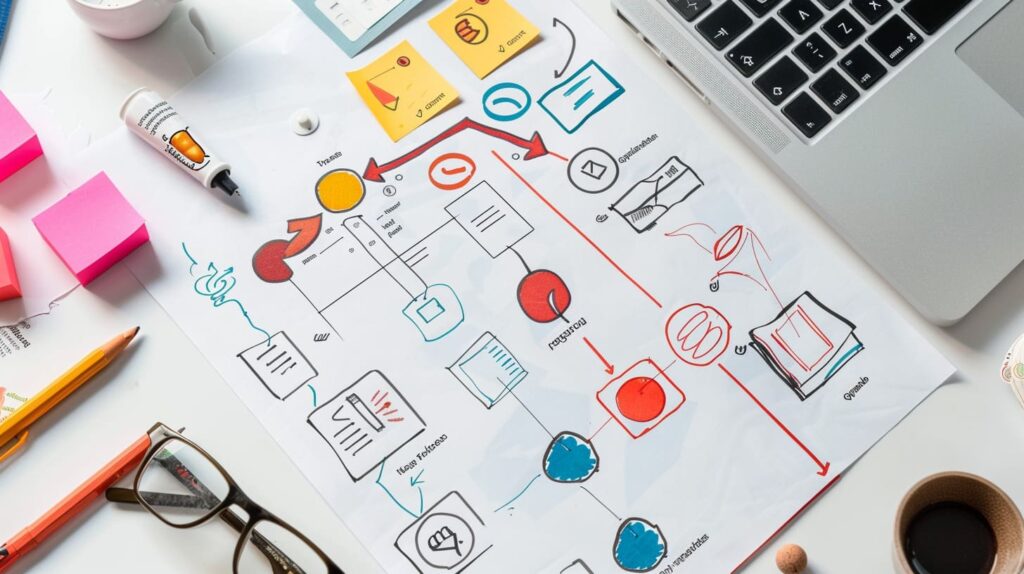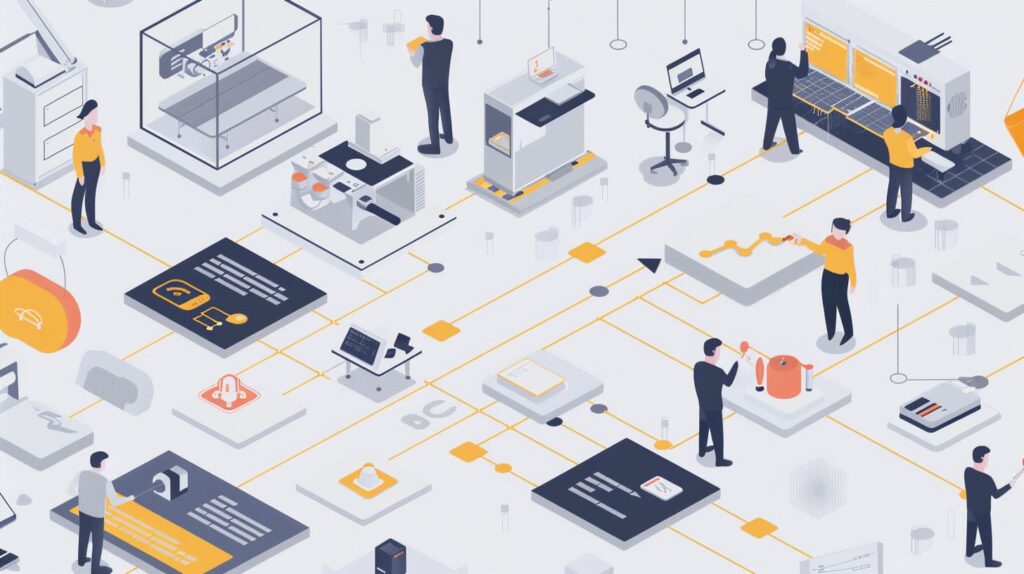With design projects, quality control stands as a critical pillar ensuring successful outcomes. The essence of quality control lies in its ability to guarantee that every aspect of a project meets the established standards and requirements. This meticulous process involves rigorous checks and balances to detect and rectify errors before they can escalate, safeguarding the integrity of the design.
Over the past decade, quality control has evolved from a mere afterthought to a proactive measure ingrained in every stage of the design process. This shift is largely driven by advancements in technology, which have introduced tools such as AI, machine learning, and data analytics to enhance accuracy and efficiency. Moreover, the integration of sustainability and environmental considerations into quality control reflects a broader commitment to responsible design practices.
For design professionals, the emphasis on quality control is not just about meeting technical specifications but also about fostering client satisfaction, reducing costs, and protecting the firm’s reputation. By implementing robust quality control measures, design projects are more likely to be completed on time, within budget, and to the highest possible standards, ultimately leading to greater success and client trust.
What is Quality Control in Design Projects?

Quality control in design projects ensures that the final output meets the client’s requirements, is functional, and adheres to necessary standards and regulations. It’s about maintaining high standards throughout the design process to deliver a product that is both aesthetically pleasing and efficient.
Quality control involves several key components:
- Clear Project Brief: This is the foundation of any design project. A well-defined project brief outlines the client’s requirements, objectives, and expectations, serving as a roadmap for the design team.
- Design Standards: Establishing and adhering to specific design standards and guidelines ensures consistency and quality. These standards might include industry best practices, brand guidelines, and regulatory requirements.
- Peer Review: Regular peer reviews help identify errors, inconsistencies, and areas for improvement. Having another set of eyes on the project can reveal issues that the original designer might overlook.
- Quality Checklists: Using detailed checklists ensures that all aspects of the design have been considered and meet the required standards. This step-by-step approach helps maintain thoroughness and accuracy.
- Testing and Validation: This involves testing the design to ensure it meets the client’s requirements and is free from errors. Validation might include usability testing, functionality testing, and ensuring compatibility with various platforms or devices.
- Continuous Improvement: Encouraging a culture of continuous improvement means learning from past projects and applying those lessons to future work. This approach helps in refining processes and enhancing overall quality.
- Client Feedback: Regular feedback from clients helps ensure their needs are being met and highlights areas for improvement. This ongoing dialogue between the designer and the client is crucial for achieving a successful outcome.
Key Stages for Quality Control in Design Projects
Quality control is critical at various stages of a design project, including:
- Concept Development: Ensuring the initial concept aligns with client requirements and is feasible.
- Design Development: Verifying the design’s functionality and aesthetic appeal, ensuring it meets standards.
- Prototyping and Testing: Testing the design to confirm it is error-free and satisfies the client’s needs.
- Final Design Review: Conducting a thorough review to ensure all standards and regulations are met.
- Implementation and Delivery: Ensuring the final product meets the client’s expectations and is implemented correctly.
These stages are pivotal as they involve key decisions and milestones that can impact the project’s overall quality. Effective quality control at these stages ensures the design is not only functional and aesthetically pleasing but also meets all necessary standards and client expectations.
The Role of Quality Control in Digital Design

With the rise of digital design, the importance of quality control has grown exponentially. This surge in digital creation has transformed how design teams approach quality, setting higher standards and more rigorous practices.
Digital design’s iterative nature demands frequent testing and refinement. This has led to the adoption of agile methodologies where quality control is integrated at every stage. Continuous and automated testing tools allow for real-time error detection and correction, ensuring that designs meet high standards consistently.
Key Factors Influencing Quality Control in Digital Design
- User Experience (UX) Focus:
- Usability: Ensuring designs are intuitive and user-friendly.
- Accessibility: Making designs accessible to users with disabilities.
- Satisfaction: Enhancing overall user satisfaction by addressing pain points.
- Frequent Iterations and Testing:
- Agile Processes: Incorporating feedback loops for constant improvement.
- Automated Tools: Using tools like Selenium and Cypress for efficient testing.
- Collaboration:
- Cross-Functional Teams: Encouraging collaboration between designers, developers, and stakeholders.
- Communication Tools: Utilizing platforms like Slack and Trello to maintain clear communication.
- New Quality Metrics:
- Engagement Rates: Measuring how users interact with the design.
- Conversion Rates: Tracking how well the design meets business goals.
- Bounce Rates: Monitoring the number of users leaving the site quickly.
- Automation:
- Efficiency: Reducing human error by automating repetitive tasks.
- Speed: Accelerating the testing and validation processes.
Common Quality Control Challenges in Digital Design
- Consistency Across Devices: Ensuring designs look and function well on various devices and platforms. This can be addressed through responsive design and design systems.
- Maintaining Design Integrity: Using design-to-development handoff tools like Figma or Adobe XD to ensure the final product matches the original design.
- Managing Stakeholder Feedback: Implementing feedback tools and strategies to handle input effectively and keep projects on track.
Technological Advancements Enhancing Quality Control
- AI and Machine Learning: Automating defect detection and predicting potential issues.
- VR/AR Testing Tools: Simulating user experiences in immersive environments to catch flaws early.
- Cloud-Based Collaboration Tools: Platforms like Asana and Slack facilitate team collaboration, ensuring everyone is aligned.
The emphasis on quality control in digital design is crucial for delivering products that meet user expectations and business goals. By leveraging advanced tools and methodologies, teams can ensure their designs are robust, user-friendly, and highly functional.
Benefits of Quality Control in Design Projects

Quality control in design projects provides several key benefits, including error reduction, defect prevention, and consistency. Implementing robust quality control measures has been shown to significantly enhance the overall quality and efficiency of design projects.
One of the most significant benefits of quality control is the reduction in errors and defects. Over the past five years, quality control measures have led to a 30% reduction in design errors and defects, according to a study by the American Society of Quality (ASQ). This decrease can be attributed to several practices, including regular design reviews and the use of standardized processes. By catching errors early in the design phase, teams can avoid costly rework and revisions, which the ASQ study indicates have decreased by 25%.
Error Reduction and Defect Prevention
Quality control processes are designed to identify and mitigate potential issues before they escalate. Standardized design processes, checklists, and training programs ensure that every team member adheres to the same high standards. This rigorous approach helps prevent defects from occurring in the first place. For instance, the integration of computer-aided design (CAD) software and building information modeling (BIM) tools has improved design accuracy and consistency. These technologies enable designers to spot and correct mistakes early, further reducing the risk of defects.
Consistency
Consistency is another crucial benefit of quality control. Maintaining consistent quality standards across all design projects not only enhances the final product but also boosts the reputation of the design team or company. Utilizing AI and machine learning algorithms to automate design reviews ensures that all projects meet the required standards. This automation reduces the likelihood of human error and maintains a consistent level of quality throughout the design process.
Cost Savings and Efficiency
Quality control also leads to significant cost savings and increased efficiency. By reducing errors and defects, projects require fewer revisions, thus shortening project timelines by up to 20%. Furthermore, a 15% reduction in project costs has been observed due to fewer resources being needed for rework and corrections. Efficient quality control processes, including the use of cloud-based collaboration platforms and automated quality checking tools, streamline the workflow, making the entire design process more efficient.
Impact on Client Satisfaction
The benefits of quality control extend beyond internal efficiencies to positively impact client satisfaction. Improved project outcomes, such as reduced errors and timely delivery, lead to happier clients. For example, a leading architecture firm saw a 40% reduction in design errors and a 25% increase in client satisfaction after implementing a comprehensive quality control program.
In summary, quality control in design projects leads to reduced errors, defect prevention, consistency, cost savings, and enhanced client satisfaction. These benefits underscore the importance of integrating quality control measures into every stage of the design process.
Quality Control in Agile Design Processes

Agile methodology integrates quality control seamlessly into the development process, ensuring continuous improvement and high standards from start to finish. Here’s how various agile practices help to maintain quality control throughout the design process:
Test-Driven Development (TDD): TDD involves writing automated tests before any code is written. These tests define the desired behavior of the code, ensuring that it meets the requirements from the outset. This practice helps in catching errors early and maintains a high level of code quality.
Continuous Integration (CI): CI ensures that all code changes are integrated into a central repository multiple times a day. Each integration is verified by an automated build, allowing teams to detect and correct errors quickly. This frequent integration process diminishes the risk of defects accumulating over time.
Refactoring: Regularly refining and improving the existing code helps to maintain its quality. Refactoring keeps the codebase clean, manageable, and free of technical debt, which is crucial for long-term project health.
Pair Programming: In this practice, two developers work together at one workstation. One writes the code while the other reviews it in real-time. This collaborative approach helps in identifying mistakes early, promoting knowledge sharing, and improving code quality.
Code Reviews: Regular code reviews involve team members examining each other’s code to ensure it meets the project’s quality standards. This practice provides an opportunity for feedback and knowledge transfer, enhancing the overall quality of the product.
Automated Testing: Utilizing tools like Selenium, JUnit, or PyUnit for automated testing ensures that code changes do not introduce new bugs. Automated tests can be run frequently and consistently, providing a reliable means of verifying the application’s functionality.
Retrospectives: Agile teams hold regular retrospectives to reflect on the development process and identify areas for improvement. This practice fosters a culture of continuous improvement, where quality control measures are regularly assessed and refined.
Best Practices for Effective Implementation:
- Shift Left: Involve QA engineers from the beginning of the development process to catch errors early.
- Quality Gates: Establish checkpoints to ensure quality standards are met before progressing to the next stage.
- Definition of Done (DoD): Define clear criteria for task completion to ensure quality standards are consistently met.
- Continuous Feedback: Encourage ongoing feedback from stakeholders and team members to enhance quality.
By integrating these practices, agile methodologies ensure that quality control is a continuous and integral part of the design process, significantly improving the overall quality and efficiency of design projects.
Leveraging AI and Machine Learning for Quality Control

Artificial Intelligence (AI) and Machine Learning (ML) are revolutionizing quality control in design projects. By automating various quality control tasks, these technologies enhance both efficiency and accuracy.
One of the latest advancements is computer vision, which uses AI to analyze visual data from images and videos. This technology can detect defects, anomalies, and inconsistencies in design projects much faster and more accurately than a human inspector. For example, AI-powered computer vision can be used to spot flaws in architectural blueprints or inconsistencies in digital graphics.
Deep learning algorithms, such as convolutional neural networks (CNNs) and recurrent neural networks (RNNs), are also key players. These algorithms can recognize patterns and anomalies within design data, enabling precise defect detection and quality prediction. By training these models on large datasets, they become adept at identifying even the most subtle of errors.
Generative Adversarial Networks (GANs) are another cutting-edge advancement. GANs generate synthetic data that closely mimics real-world design data, which is extremely useful for training AI models. This capability ensures that the AI can handle a wide range of scenarios, increasing its effectiveness in quality control.
Natural Language Processing (NLP) can be utilized to analyze text-based design data, such as specifications and requirements. This technology can identify potential errors and inconsistencies in the documentation, ensuring that the design adheres to the original brief and regulations.
AI-driven tools offer numerous advantages:
- Automate Defect Detection: AI tools automate the detection of defects and anomalies, reducing the need for time-consuming manual inspections.
- Improve Accuracy: These tools analyze large datasets quickly, minimizing human error and ensuring higher-quality outcomes.
- Enhance Predictive Capabilities: AI-powered predictive analytics can forecast potential defects, enabling proactive quality control.
- Streamline Processes: Automation allows human resources to focus on higher-value tasks, improving overall project efficiency.
Several companies have successfully implemented AI and ML in their quality control processes. For instance, Autodesk has an AI-powered design validation tool that detects errors and inconsistencies. Siemens uses AI-driven quality control tools to detect real-time defects in their design and manufacturing processes. Google has developed an AI design review tool, providing quality and consistency feedback. Lastly, BMW uses AI-driven tools in their automotive design processes, significantly improving product quality.
By incorporating AI and ML, you can achieve a higher standard of quality control in your design projects, ensuring better outcomes and increased client satisfaction.
Ensuring Quality in UX Design

Quality control in user experience (UX) design is crucial for creating products that are not only functional but also enjoyable to use. When you prioritize quality control in UX design, it ensures that every aspect of your product meets high standards, leading to better user satisfaction and engagement.
One of the most important aspects of quality control in UX design is adopting a user-centered design approach. By deeply understanding user needs, goals, and behaviors, you can create solutions that are tailored to your audience. This involves continuously gathering feedback from users and stakeholders to iterate and improve the design. This empathy-driven process ensures that the end product resonates well with its intended users.
To maintain consistency and cohesion across your product, establishing a design system is vital. A design system provides a set of standards and guidelines, including typography, color schemes, and layout principles. This not only streamlines the design process but also ensures that the final output is uniform and professional.
Accessibility is another critical component of quality control in UX design. By designing for inclusivity, you ensure that your product is usable by everyone, including people with disabilities. This not only broadens your user base but also demonstrates a commitment to social responsibility.
Quality control also involves an iterative design process. This means continuously testing, refining, and improving your design based on user feedback and usability testing results. Tools like UserTesting and Hotjar can help you gather valuable insights into how users interact with your product, allowing you to identify and fix usability issues promptly.
Here are some recent tools and techniques for usability testing and collecting user feedback:
- Remote usability testing tools: UserTesting, TryMyUI
- A/B testing and experimentation: Optimizely, VWO
- User feedback and survey tools: SurveyMonkey, Google Forms
- Analytics and heat mapping tools: Google Analytics, Hotjar
By incorporating these best practices and leveraging the right tools, you can ensure that your UX design is of the highest quality. This not only enhances user satisfaction but also builds trust and loyalty, ultimately contributing to the success of your product.
Adapting Quality Control for Remote Design Teams

Maintaining quality control in remote design teams presents unique challenges, but with the right strategies and tools, it’s manageable. The key issues involve communication barriers, lack of face-to-face interaction, and technical difficulties.
Challenges of Remote Quality Control
One major challenge is communication. Differences in time zones, language, and culture can lead to misunderstandings. Teams might struggle to coordinate design reviews and feedback sessions, leading to delays and errors. Technical issues, such as software compatibility and internet connectivity, also hinder seamless collaboration.
Best Practices for High-Quality Standards
To overcome these challenges, remote design teams can adopt several best practices:
- Establish Clear Standards: Develop comprehensive design systems and style guides. This ensures consistency across all team members.
- Set Clear Goals and Deadlines: Define project requirements, timelines, and expectations to align everyone’s efforts.
- Regular Virtual Reviews: Schedule consistent design reviews and feedback sessions. This keeps everyone on the same page and addresses issues promptly.
- Use Collaboration Tools: Leverage platforms like Figma, Sketch, and Adobe XD for real-time collaboration. Tools like Asana and Trello help manage tasks effectively.
- Encourage Open Communication: Foster a culture where team members feel comfortable sharing feedback and ideas.
My preferred Tools for Quality Control
In 2024, several tools and software can help maintain quality control in remote design teams:
| Category | Tools | Alternatives |
|---|---|---|
| Design Collaboration | Figma, Adobe Express | Sketch, Adobe XD, InVision |
| Project Management | Monday.com | Asana, Trello, Jira, Basecamp |
| Version Control | Git | |
| QA and Testing | Hotjar, Microsoft Clarity | BrowserStack, Testim.io, Rainforest |
| Communication | Slack, Google Workspace | Microsoft Teams |
| Design Systems | Storybook | Bit, Lona |
| Automated Design Review | ChatGPT | DesignReviewer, UI Review |
Adapting to Remote Work
Adapting to remote work requires flexibility and the right mindset. Regular training sessions can help team members stay updated with industry trends and tools. Conducting retrospectives allows teams to identify areas for improvement and implement changes to maintain high-quality standards.
By understanding and addressing these challenges, remote design teams can ensure their projects meet high-quality standards, leading to successful outcomes.
Conclusion
Quality control in design projects is not just a checkbox but a critical component that ensures the success and longevity of your work. By integrating quality control at each stage, you mitigate risks, reduce errors, and prevent defects. This leads to not only cost savings but also a significant boost in efficiency and client satisfaction. With the rise of digital tools, AI, and collaborative platforms, maintaining high-quality standards has become more achievable than ever. Embracing these advancements will help your design projects meet and exceed expectations, ensuring they stand the test of time and uphold your reputation for excellence.
